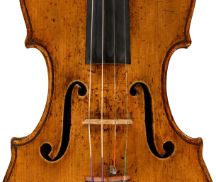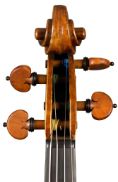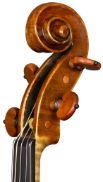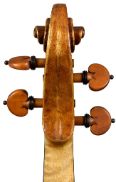Violin, Giuseppe Guarneri del Gesù, Cremona, 1741, “ex Carrodus”
Printed label: “Joseph Guarnerius fecit [cross] / Cremonę anno 1741 IHS” (41 handwritten)This violin is a typical example of the late period of the master luthier from Cremona. The model is somewhat broader than that of the “ex Sorkin” violin built ten years earlier; the C-bouts look open and the corners are shorter. The arching s moderately higher than that of the earlier violin. The hole in the middle of the back plate – a hallmark of del Gesù’s work – can be seen from the outside. The scroll and the edge of the back plate exhibit toolmarks that del Gesù did not smooth down and that are indicative of his rapid handiwork. The two-piece belly has medium-wide annual rings and a light hazel figure. A dendrochronological report dated the most recent annual ring at 1738. The two halves of the belly are from the same log, and the chronology is highly correlated with those of other instruments, specifically with instruments made by Antonio Stradivari. Only three years lie between the youngest annual ring and the year in which the violin was made. Hence, del Gesù apparently used the wood after a very short seasoning period. The divided back has medium-wide flames descending slightly toward the bass side. The structure of the rib wood corresponds to that of the back. The medium-high arching begins at the edge with almost no fluting. The slender f-holes are typical of del Gesù’s style, with exceptionally narrow wings on this instrument. They are cut with a deft hand and look a bit asymmetrical. Unlike Stradivari, del Gesù seems to have opted for speed over precision in carving the pegbox and scroll. As these violin parts have no impact on sound, del Gesù saw no need to achieve symmetry or to make the volutes smooth and regular. Today, his decision to dispense with optical perfection is not considered a flaw but rather a mark of his personality. The shape of the deeply cut volute of the 1741 violin is harmonious but slightly asymmetrical. The eye on the bass side is somewhat lower than its counterpart on the treble side.
This violin’s history can be traced all the way to the early 19th century. Its first prominent owner was François Cramer, who was born in Schwetzingen, Germany, in 1772. One year later, Cramer’s father (a well-known violinist) moved to London with his family. François Cramer was appointed Master of the King’s Music in 1834. Shortly before he died, François Cramer sold the instrument to Sir Alexander Mackenzie, violinist and conductor at the Theatre Royal in Edinburgh at the time. W. E. Hill company sold the violin to John Tiplady Carrodus (1836–1895), in whose honor the instrument was named. Contemporaries cited Carrodus as England’s leading violinist. Carrodus owned another violin made by Guarneri del Gesù in 1743, which also bears his name today. After Carrodus died, the violin remained in the family until the early 20th century. Later owners include many renowned collectors and musicians, among them US violinist Aaron Rosand.












